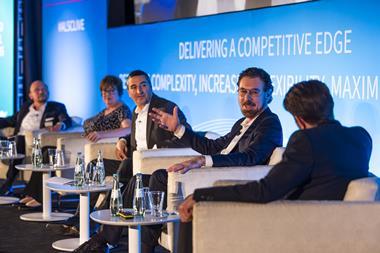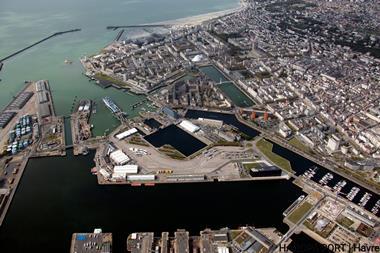
Despite Russia’s evident difficulties, Gefco Russia is continuing its aggressive growth strategy, with plans to develop trans-Eurasian logistics and grow its market share in the domestic market. The company is even on the acquisition trail. According to Vladimir Yakunin, president of Russian Railways (RZD), the state-owned rail giant that owns 75% of Gefco, trans-Eurasian logistics will be the main development area for both RZD and Gefco, as demand for cargo supplies between Russia and China is set to grow rapidly.
At a joint press conference with Gefco this past winter, Yakunin announced a new, large-scale project, the ‘Trans-Eurasian Belt Razvitie’ [development], which will develop major rail networks in Russia to link directly with Europe, China and other Asian countries. The project will also see the creation of new logistics flows by Gefco in conjunction with the Joint Transport and Logistics Company (a joint venture between the governments of Russia, Belarus and Kazakhstan).
Luc Nadal, Gefco’s chairman, noted a rising interest in rail transport for automotive logistics in Russia. Analysts have suggested that further development of the Belt Razvitie was one of the main reasons why RZD purchased Gefco in 2012, although Nadal said Gefco does not benefit from RZD in terms of prices, and that cooperation between the companies for rail will take place on market principles. That is important for Gefco’s third party logistics business in Russia, where it acts as a transport integrator and purchaser for customers like PSA Peugeot Citroën and General Motors.
The project is expected to include several extensions to the Trans-Siberian Railway and the Baikal-Amur Mainline, to increase the cargo railway network connecting the European and Asian parts of Russia. Currently, the total capacity across these lines is 100m tonnes of cargo a year, which was reached in 2010. If the project goes ahead, carrying capacity could reach 500m-600m tonnes per year, which will require new infrastructure, the cost of which Yakunin said “should be estimated in the trillions, and not in our roubles.”
One aspect of the new project will be the movement of containerised cargo, including vehicles, from northern provinces of China, through Russia’s eastern ports and onto delivery in the south of China, Japan, South Korea and other countries. Gefco has run several trial shipments moving vehicles by rail in containers over the past year, including shipping vehicles this way between Germany and China.
Yakunin expects that the Belt Razvitie project will eventually help Gefco to treble its annual profits over the coming decade; RZD anticipates receiving a dividend from Gefco that will reach €74m ($83.6m) in 2015, €108m in 2016, and €3.75 billion for the period between 2015 and 2030.
Despite these ambitions, the overall picture remains clouded by EU sanctions and the fall in the rouble. Business is not helped by the fact that Yakunin is among those on the US sanctions list – although he has not been censured by the EU.
Global uncertainty and new contracts
Although Gefco’s growth last year was ahead of the average for the global logistics market, current trends have negatively affected it in some regions. According to Nadal, Gefco benefited from recovery in Europe, including in its major markets in France and Spain, while it also managed to cut costs. However, the company has conservative expectations in Europe, where it relies primarily on existing customers across the region. Elsewhere, Gefco faces difficulties in South America, where its largest customer, PSA, has struggled in Brazil, and the Argentine market has hit the wall.
In Russia, despite the current crisis, Nadal is more optimistic and Gefco plans to occupy 20% of the country’s logistics market, excluding commodity transport, compared to a 6% share in 2013. The company currently has large Russian contracts with Peugeot, Citroën and GM (although latter has just announced that it would scale back sales and production), and last year it signed around 50 new deals worth $150m in business, including to ship Toyota vehicles from the ports of the Black Sea to Uzbekistan, as well as to move the vehicles of two “well-known” German OEMs to the Russian market, Nadal said.
Across the 1520 zone – which includes mainly former Soviet countries – Nadal said Gefco has established cooperation with 15 new clients; while traffic is low, it is a promising direction.
Currently logistics account for around 20% of total business costs in Russia – two or three times more than in Europe – and Nadal thinks that companies like Gefco can help to reduce this if outsourcing increases. The difficulties ahead make it tricky to outline solid investment plans, but Gefco is looking to purchase a local company to boost its business, and is currently researching two possibilities, he revealed.
Despite the uncertainty, Nadal still expects recovery in the medium term. “We remember that in 2008-2009 there was a significant drop in the automotive market in Russia, so now we are looking forward to the same recovery,” he said. “Most important, however, is that our customers are confident Gefco will support them, regardless of the state of the market.”
See also: RZD expects dividend from Gefco, Gefco sees growing interest in Eurasian rail
Logistics experts from OEMs and logistics providers will get the chance to talk through strategies for managing through the current challenges in Russia during the annual Automotive Logistics Russia conference, which will take place in Moscow on June 24th. Click here for more details.






















